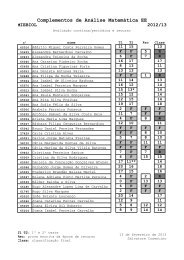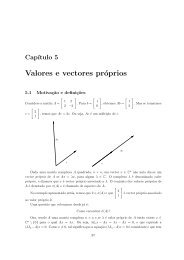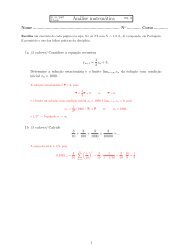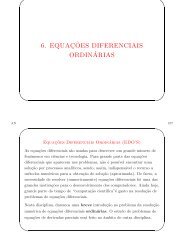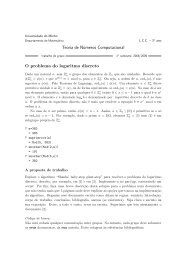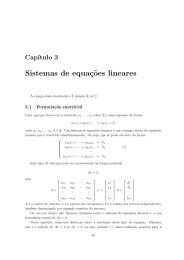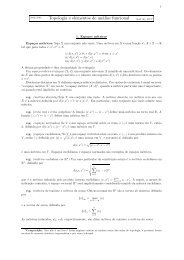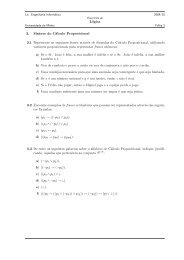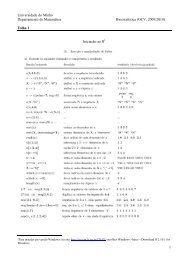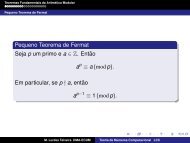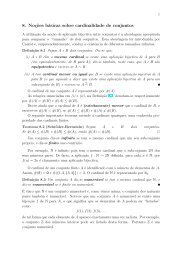My title - Departamento de Matemática da Universidade do Minho
My title - Departamento de Matemática da Universidade do Minho
My title - Departamento de Matemática da Universidade do Minho
You also want an ePaper? Increase the reach of your titles
YUMPU automatically turns print PDFs into web optimized ePapers that Google loves.
15 DIMENSIONS, FRACTALS AND ENTROPY 99<br />
von Koch snowflake.<br />
The snowflake may be <strong>de</strong>fined as the invariant set K ⊂ C for the IFS<br />
z ↦→ az<br />
z ↦→ a + (1 − a)z<br />
with a = 1 2 + i 1 √<br />
12<br />
.<br />
De Rham’s curves.<br />
33<br />
Paul Lévy’s dragon curve.<br />
The Lévy’s dragon, or Lévy C curve, is a curve with non-empty<br />
interiror 34 z ↦→ az z ↦→ a + az<br />
with a = 1 2 + i 1 2 .<br />
Leaves. Using affine contractions of the plane R 2 ,<br />
f k : x ↦→ A k x + α k<br />
with A k ∈ M 2×2 (R) and α k ∈ R 2 , playing with their parameters, Michael Barnsley was able to<br />
reproduce patterns similar to the one observed in ferns.<br />
Below are different kinds of Barnsley fern.<br />
Pictures taken from http://en.wikipedia.org/wiki/Barnsley’s_fern<br />
15.4 Kleinian groups<br />
[MSW02] . . .<br />
to be <strong>do</strong>ne<br />
15.5 Entropia topológica<br />
O fenómeno <strong>da</strong> <strong>de</strong>pendência sensível <strong>da</strong>s condições iniciais por ser “quantifica<strong>do</strong>”, e isto produz<br />
um importante invariante topológico chama<strong>do</strong> “entropia topoloógica”.<br />
Entropia topológica. Seja f : X → X uma transformação contínua <strong>do</strong> espaço topológico<br />
compacto X. Se d é uma métrica que induz a topologia <strong>de</strong> X, po<strong>de</strong>mos <strong>de</strong>finir uma família <strong>de</strong><br />
métricas d n , <strong>de</strong>pen<strong>de</strong>ntes <strong>do</strong> tempo n ≥ 0, por meio <strong>de</strong><br />
d n (x, y) = max d ( f k (x) , f k (y) )<br />
0≤k≤n<br />
Ou seja, d n (x, y) é “a distância máxima distância entre as n-trajetórias <strong>de</strong> x e y”.<br />
Se pensamos em ε > 0 como a precisão <strong>do</strong>s nossos instrumentos, N ε (X, d n ) representa “o<br />
número mínimo <strong>de</strong> n-órbitas necessárias para <strong>de</strong>screver as órbitas <strong>de</strong> to<strong>do</strong>s os pontos <strong>de</strong> X com<br />
erro ≤ ε”, e S ε (X, d n ) representa “o número máximo <strong>de</strong> n-órbitas que os nossos instrumentos<br />
com sensibili<strong>da</strong><strong>de</strong> ε conseguem distinguir”. Se X é compacto, estes números são finitos, e crescem<br />
quan<strong>do</strong> n cresce e quan<strong>do</strong> ε <strong>de</strong>cresce.<br />
33 G. <strong>de</strong> Rham, Sur quelques courbes définies par <strong>de</strong>s équations fonctionnelles, Rend. Sem. Mat. Torino 16<br />
(1957), 101-113.<br />
34 P. Lévy, Les courbes planes ou gauches et les surfaces composées <strong>de</strong> parties semblables au tout, J. Ecole<br />
Polytechn. (1938), 227-247, 249-291.



